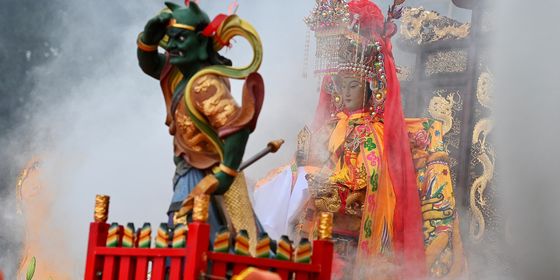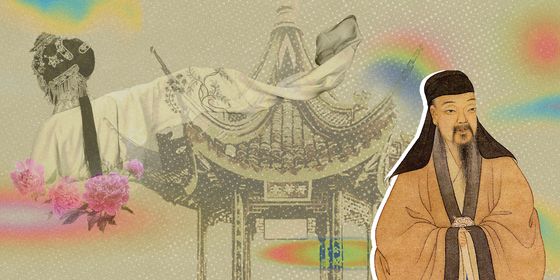Tigers have represented bravery, strength, and authority for centuries in Chinese culture
Mao Zedong may have popularized the term “Paper Tiger (纸老虎)” in English, to describe the terrifying appearance but unthreatening reality of America’s nuclear weapons during an interview in 1946, but the term had been around for centuries in Chinese before that. Indeed, the tiger has been a symbol of strength and majesty since ancient times in China, and is thought to ward off evil spirits.
The Year of the Tiger, the third in the cycle of the 12 Chinese zodiac animals, is now nearly upon us, and with the fearsome feline believed to be “the king of all beasts,” it is perhaps the most desirable zodiac animal after the dragon. Indeed, Chinese often depict the stripes on the animal’s forehead in the shape of the Chinese character “王,” meaning “king.”
The White Tiger, or “白虎” in Chinese, is one of four major star constellations identified by ancient Chinese, known as “四象 (sìxiàng, Four Symbols).” The tiger is found in the west of the night sky, along with the Azure Dragon of the East (东方青龙), the Vermilion Bird of the South (南方朱雀), and the Black Tortoise-Snake of the North (北方玄武). These four beasts were known as the “Four Mythical Animals (四神兽)” or “Four Spirits of Heaven (天之四灵),” with the White Tiger worshiped as the guardian god of the west.
Though the tiger is the only animal among the Four Symbols that is not mythical, it is often described as a “deity” in Chinese literature. In The Classic of Mountains and Seas (《山海经》), a compilation of stories about mythic geography and beasts believed to have been written before the Han dynasty (206 BCE – 220 CE), the god of Kunlun Mountain, Lu Wu (陆吾), has the body of a tiger, nine tails, and tiger paws—though with a human face.
Ancient Chinese worshiped tigers because of their majestic and strong appearance, and believed they could ward off evil spirits. In his book, Comprehensive Meaning of Customs and Mores (《风俗通义》), Ying Shao (应劭), a scholar in the Eastern Han dynasty (25 – 220), wrote: “The tiger is a ‘yang’ animal [according to China’s yin-yang philosophy], and the king of all beasts. It can quell war and devour ghosts.” He also claimed that “drawing a picture of a tiger on your door means ghosts won’t dare to enter.” People still hang tiger pictures at home today, believing they can protect the house and the family. Parents and grandparents also often dress their children in shoes (虎头鞋) and hats (虎头帽) with tiger-head patterns, as protection from evil spirits and to keep them healthy.
Tiger symbolism is also frequently used in military settings. A brave and skillful general, for example, is known as a “虎将 (hǔjiàng, tiger general).” Those who walk with a majestic or imposing gait are described as “龙骧虎步 (lóngxiāng hǔbù, walk with dragon and tiger steps);” a term mostly used to describe military generals.
As early as the Spring and Autumn (770 – 476 BCE) and Warring States (475 – 221 BCE) periods, tiger-shaped tokens, known as “tiger tallies (虎符 hǔfú),” were used to command troops. These were tiger figurines made from bronze or gold-plated metal with inscriptions on their back, and were divided into two halves. Multiple unique tallies were created, with the right halves kept at court the king or ruler, and the left halves given out to military generals. To command the troops of a specific general, the ruler would send his orders along with his half of the general’s tiger tally—only if the inscriptions on the two halves matched would the general follow the instructions. This was meant to ensure only the ruler had the right to command his troops, and avoided enemies or rogue commanders giving false orders or taking matters into their own hands.
These tiger tallies played a vital role in ancient warfare. The story “Lord Xinling Steals a Tiger Tally to Save Zhao,” from the Records of the Grand Historian (《史记》), by Sima Qian (司马迁) of the Han dynasty, remains a household tale today: During the Warring States period, the State of Qin attacked the State of Zhao, and seized the Zhao capital Handan (in present day Hebei province). Lord Pingyuan (平原君), an official of Zhao, asked his brother-in-law Lord Xinling (信陵君), a noble of the State of Wei, for help. Lord Xinling was convinced that allying with Zhao to fight against Qin would benefit Wei in the long term, as the Qin state would become too powerful without being checked. But when Lord Xinling reported Zhao’s request for help, the king of Wei hesitated, worried that the Qin army might destroy his forces if he moved against them.
Lord Xinling was dismayed, and called in a favor from one of the king’s concubines, whom he had previously helped to avenge her father’s murder. He asked her to steal one of the king’s tiger tallies, and with the half-tiger in hand, Lord Xinling commanded the armies of Wei to attack the Qin army, won the battle, and saved the State of Zhao.
There are no tiger tallies in use for ordering troops around now, but tigers are still referenced in the name of military regiments—like the Flying Tigers (飞虎队 Fēihǔ Duì), a squadron of volunteer American pilots who helped China fight Japanese invaders in the 1940s. Meanwhile, the central government anti-corruption drive since 2012 has targeted high-profile officials nicknamed as “tigers,” as well as low-level lackeys called “flies”—“Tiger caught!” reads a headline from Tencent News this month after a court handed Wang Fuyu, former Party Secretary of Guizhou, a commuted death sentence for accepting bribes worth over 434 million yuan (68 million US dollars).













